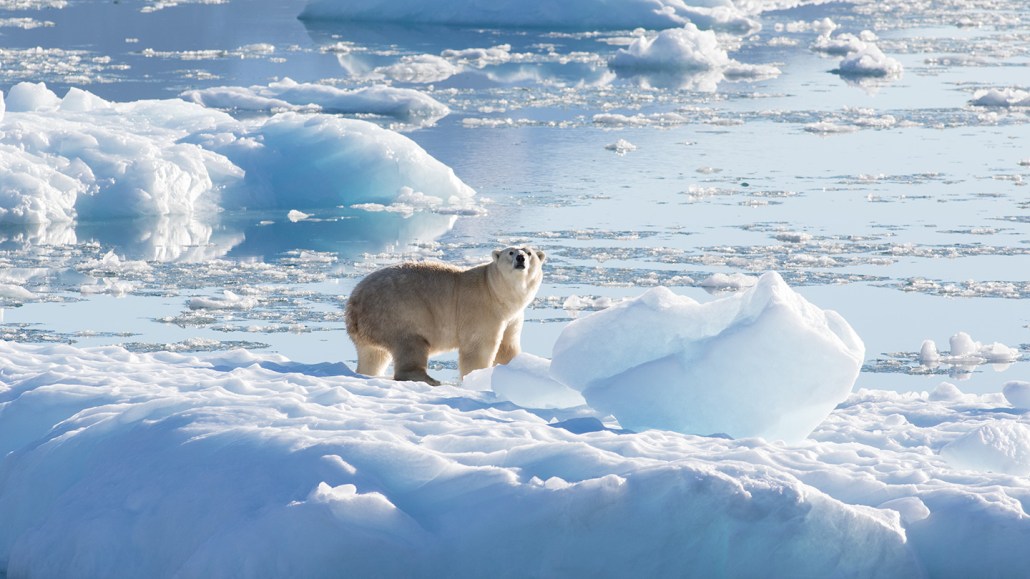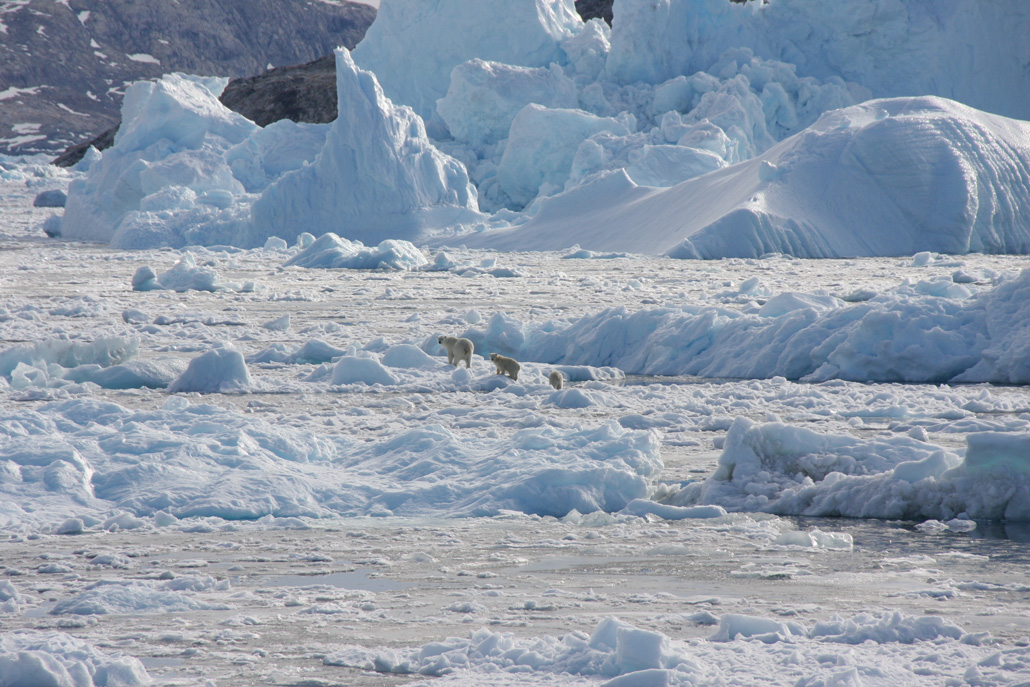Some Greenland polar bears are surviving with very little sea ice
They’ve been getting by in fjords on ‘glacial mélange’ — a mix of ice, snow and slush

This polar bear was photographed in southeast Greenland in September 2016. It’s standing atop glacial mélange — a floating mix of icebergs, snow and sea ice fragments that exists there year-round.
Thomas W. Johansen/NASA Oceans Melting Greenland
Share this:
- Share via email (Opens in new window) Email
- Click to share on Facebook (Opens in new window) Facebook
- Click to share on X (Opens in new window) X
- Click to share on Pinterest (Opens in new window) Pinterest
- Click to share on Reddit (Opens in new window) Reddit
- Share to Google Classroom (Opens in new window) Google Classroom
- Click to print (Opens in new window) Print
By Nikk Ogasa
Pihoqahiak is an Inuit name for the polar bear. It means “ever-wandering one.” And that name is apt for a creature known to roam vast expanses of sea ice, sometimes plodding thousands of kilometers (more than 1,200 miles) a year in search of meals. But along the jagged coastline of southeast Greenland, some isolated polar bears are surviving as homebodies. Here, the bears hunt in fjords that lack sea ice most of the year.
Scientists shared their surprising discovery in the June 17 Science.
Most polar bears (Ursus maritimus) follow the sea ice as it grows and recedes throughout the year. But in this part of Greenland, the sea freezes over for just a few months. When it melts again, deep-sea inlets known as fjords emerge along the coasts. Resident polar bears here have adapted to hunting from what’s known as glacial mélange (May-LAAHNJE). It’s a floating mishmash of icebergs, snow and fragments of sea ice. This so-called mélange persists year-round near the front of glaciers that spill into these fjords.
These polar bears are “residents in fjords that are sea ice–free for more than eight months of the year,” says Kristin Laidre. “Normally, a polar bear wouldn’t be able to survive without sea ice for that long,” says this biologist. She works at the University of Washington in Seattle.
Polar bears rely on sea ice as the platform from which they hunt for seals. But as Earth’s global temperatures have been rising, that ice has been disappearing. And that’s been causing problems for the polar bears in the Beaufort Sea (along the north coasts of Alaska and Western Canada) and in Canada’s Hudson Bay. Some bears have traveled so far in search of an ice retreat that they risk starving.
Arctic polar bear populations have begun shrinking. Researchers estimate that most populations of these bears will collapse by 2100 unless emissions of climate-warming greenhouse gases are sharply cut back. For now, the International Union for Conservation of Nature classifies polar bears as “vulnerable” to extinction.
The fjords of southeast Greenland and similar, small regions could become a last, temporary refuge for some of the remaining polar bears. Yet even they will disappear if climate change continues to melt the sea ice on which this species depends. That’s the conclusion Laidre and her colleagues come to. Glacial mélange isn’t widespread in the Arctic. And what little exists could disappear if temperatures rise much more.
These fjord bears are a just a small subgroup
No one knows for sure how many polar bears dwell in the fjords of southeast Greenland. Laidre and her colleagues estimate it’s only several hundred. These bears came to the researchers’ attention while they were studying the species along east Greenland’s coast. Indigenous peoples there hunt the bears as part of their subsistence diet. Those people wanted advice on how big a threat they were to the bears.
So the researchers put satellite-linked radio collars on 83 polar bears between 1993 and 2021. Data from those collars showed that bears living south of about 64° N latitude don’t tend to interact with bears to the north, and vice versa.
The southeastern group may be fairly isolated by Greenland’s ice sheet to the west and a rapid south-traveling ocean current to the east.
In northeast Greenland, the median distance traveled by collared bears was 40 kilometers (about 25 miles) every four days. But in the southeast, the median distance traveled was just one-fourth that far. Bears in the southeast sometimes traveled between neighboring fjords. Others might stay in the same fjord all year.
In terms of travel, “for a polar bear, that’s nothing,” says Steven Amstrup. He’s a zoologist who was not involved in the study. But he knows these bears; he’s chief scientist of the conservation organization Polar Bears International, based in Bozeman, Mont. “Apparently,” he says, those southeast Greenland bears are “finding enough resources there that they don’t have to make these huge, big movements.”

Learning to live on the mélange
Southeast Greenland bears do hunt on sea ice where it’s present, the researchers found. They make it home for a few months each winter and spring.
For the rest of the year, the bears hunt from the glacial mélange that now packs the fjords. “They use it just like sea ice,” Laidre says. “They’re able to walk [and hunt] on the mélange … and they can swim around between the pieces of ice and ambush seals.”
It’s not entirely surprising that polar bears have settled at the fronts — or toes — of glaciers in the fjords, Amstrup says. “Oftentimes, the toes of these glaciers are very productive areas,” he says, meaning rich sources of food. Glacial meltwater can flush nutrients from deeper in the ocean up toward the water’s surface. This can draw fish to the area. Seals that go out to feed on these fish, he suspects, might end up as a bear’s dinner.
The researchers also analyzed rare genetic variations in the southeast Greenland bears. The sampled animals shared a common ancestor about 200 years ago. And they’re so isolated that these bears have essentially kept that genetic inheritance to themselves. “They’re the most genetically isolated polar bears in the world,” Laidre says. Conserving this unique group of bears, she says, will be important for protecting the species’ genetic diversity, which is already low.
But despite having learned to adapt to their slushy world, even southeast Greenland polar bears will perish without human climate action, Laidre and Amstrup agree. “Loss of Arctic sea ice is still the primary threat to all polar bears,” Laidre says. “This study does not change that.”







